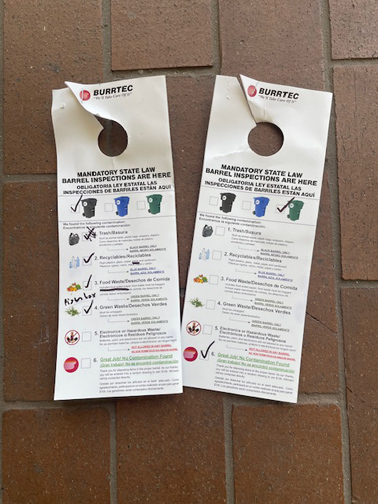
By Mary O’KEEFE
Many residents throughout LA County have either received or will receive a type of report card on their garbage bins. This is in response to the Mandatory State Law Barrel Inspections.
The statewide law, SB 1383, went into effect on Jan. 1, 2022 and requires every jurisdiction to provide organic waste collection services to all residents and businesses. California residents were required to separate their organic waste.
CVW wrote about this law when it was first implemented; however, now residents are finding out how well they did in every regard concerning garbage. They are finding cards stapled to their garbage bins with checkmarks that either state they are doing a “Great Job” or need to improve.
Burrtec, which is the waste management company for unincorporated Los Angeles County/La Crescenta-Montrose, has contracted with a third-party vendor, Re-Create, according to Andrew Jacoby, division manager at Burrtec Waste Industries. These waste inspectors can be seen in neighborhoods, looking into bins and taking notes.
“The Re-Create team is circling or underlining items that are located in the incorrect container,” Jacoby said.
A detailed barrel guide can be found at https:www.burrtec.com/barrel-guide.
In that guide Burrtec lists what plastics can be recycled, including #1 to #7 plastics. That list of what ranking is given to plastics can be found at https://tinyurl.com/5b86xrnd.
“As far as plastic bags [like those from stores] we ask that you please place them inside the trash container,” he said.
Jacoby said there are no penalties for receiving a “bad grade” on one of the cards. The outreach is a way to educate the public on what wastes go into which bin.
However, CVW has found that some residents have been contacted by their waste management company stating it would no longer pick up the bins if the resident was separating garbage in a proper way.
Jacoby said that is not Burrtec’s policy. If residents are confused or concerned about the card they find on their waste bins, Jacoby advised them to call their waste management company.
There are things that customers can do to help Burrtec workers.
“Currently, one of the key components is bagging food waste before placing it in the green organics barrel. This includes items like eggshells, fruit peels, leftovers, spoiled food and food-soiled paper, etc.” Jacoby said. “The second most important item is not placing glass, trash or other recyclables in the green organics barrel.”
Background on SB 1383
The goal of the law is to reduce food waste in landfills by 75%. It went into effect on Jan. 1, 2022, but it took some time for local waste management companies to come up with and distribute a plan.
When food waste breaks down it releases methane into the atmosphere. Methane is a greenhouse gas. In the U.S., food waste is estimated at between 30% and 40% of the food supply. This is based on an estimate by the U.S. Dept. of Agriculture (USDA) of 31% food loss at the retail and consumer levels. This added up to approximately 133 billion pounds and $161 billion worth of food in 2010, according to the USDA.
“In the U.S., food is the single largest category of material placed in municipal landfills where it emits methane, a powerful greenhouse gas. Municipal solid waste landfills are the third-largest source of human-related methane emissions in the U.S., accounting for approximately 14.1% of these emissions in 2017,” according to the U.S. Environmental Protection Agency.
Organic food wastes include fruits, vegetables, dairy, bread, meat, seafood plate scraps and expired food. Food–soiled paper without plastic or other non-paper lining is also an organic waste as well as yard trimmings. Cooked and raw meat can be placed in the collection pail then deposited in the green can with residential trash only; businesses have to have outside handlers to process.
